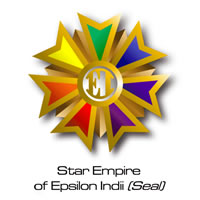 |
Andorian
Logo |
Andorians are blue-skinned humanoids with white hair. Their slim builds conceal the well-muscled bodies of warriors.
They have a pair of knobbed antennae extending from the sides of the crown of the head. These "antennae'' are actually extensions of their sinus cavities, giving the Andorians a great sensitivity to minute variations in pressure and temperature. They have an elevated aural sensitivity and an enormously enhanced sense of smell. The actual receptors are situated within the depressions at the tips of the "antennae'' and are protected by the hard cartilaginous tissue that keeps the "antennae'' rigid. Their visual acuity is also well above human standards. Andorians are somewhat thinner than most humans, but weigh equivalently, and are somewhat faster in movement and reaction time.
None of the Andorian sexes is truly male or female as humans might define them. Andorians do, however, accept male or female pronouns in order to simplify their interactions with the various two-sex species that dominate the Star Trek universe, and to avoid unwelcome questions about their biology.
Andorian history is one of conflict, though they do not battle without reason. The martial spirit is still alive in Andorian culture. Andorians are extremely disciplined, possessing a strong sense of duty and personal honor, and so they make excellent military officers.Though they are stoic and largely unsentimental, they do respect and revere family ties.
Andorians are fond of technology, but they insist on its use with respect for nature. For this reason, their early wars of conquest were fought with a regard for planetary environment, and so the Andorians avoided much of the ecological devastation suffered by Terran Humans and many other cultures.
They are a hard-working and serious folk, who are often but incorrectly viewed as humorless and irritable. In fact, Andorians have a complex set of propositional "grammars'' by which they express humor, and as such they do not tend to find human humor amusing, nor do non-Andorians tend to "get'' their humor. As to the irritability, the harsh history of early Andorian civilization has left a strong taboo against the appearance of frivolity or wasted effort.
Often, Andorians feel uncomfortable when invited to pursue purely recreational activities or pastimes. Their curt refusals often make them seem prudish or unsociable, while in fact they simply don't have a strong cultural pragmatism for engaging in such activities.
Andorians are also reluctant to enter into strong personal relationships outside their bondmates, another left over trait from their troubled past. This lack of a social skill so common in almost all other Federation races simply reinforces the sense of isolation and distance that others perceive between an Andorian and themselves.
Because of the requirement of a quad and matched bondmates to increase the chances of reproduction, the Andorian species is decreasing in number with each generation. It is a foregone conclusion that they will go extinct if some manner of increasing their population is not found. Recently, it was discovered that secret genetic resequencing research has been ongoing, unsanctioned by the government, that would reduce the 4-gender species to two. There is also a philosophical movement ongoing that would allow Andorians to seek their own bondmates instead of being assigned them at birth.
As a key member of the Federation, Andorian Ambassador Shras represented Andoria at the Babel Conference in 2268, at which it supported the admission of Coridan as a new member of the Federation.
Beta Quadrant. Andor is the home planet of Andorians, called FESOAN in the Andorian language. Andor is a barren moon orbiting a gas giant - eighth out of nine planets in the Epsilon Indi system in the Aratain Sector. It is mostly a large, hot, dry world with little surface water, and a gravity of 0.9g. There are, however, vast underground reserves that feed surface geysers heated by geothermal energy. Oases surrounding these geysers are the centers of the planet's main population areas, since the great majority of Andor's plant life thrives where subsurface water is plentiful. Located in the system Epsilon Indi, with a thinner atmosphere than Earth, and a cold, rainy, windy climate for nine months of the Andorian year. The population is actually around 90 million people. The planet circumference is about 56.500 Km. Andor shares the gas giant's orbit with two other moons. Their day is 32 hours long.
Spring typhoons generate grey-green storm clouds.
The planet has a 15/85 land-to-water ratio, with two major continents and a number of islands.
Geographical Locations:
The Archipelago: is the oldest inhabited region on the planet.
Zhevra: Continental mass with moderate climate.
Vezhdar Plain: On Zhevra.
Great Rift Range: On Vezhdar Plain.
Hill Country: On Zhevra.
Has gritty slot canyon walls commonly about.
Cheshras Island: A major population center.
Eastern Archipelago
Khyzhon Sea: Cobalt Blue in color.
Thelasa-vei: One of the main provinces located on Cheshras Island. Tends to be stormy. It's primary city is called Harbortown.
Harbortown: Andor's oldest and third largest city. Built into the planet's largest natural harbor. Started out as several small fishing villages dug into mountainsides, but gradually expanded into the parcel between two of Cheshras major rivers. Was built on the largest peninsula between the Frost and Moss rivers. The top 50 levels of the city on the mountainside are inhabited by 'modern' Andorians, the lower disused levels by extremists who prefer to live in the 'old days'.
Hand of Cheshras: The four major rivers that converged near Harbortown, creating five land “fingers.”
Shayel Island
Wethesa
Nitra Bridge: A kilometer-long pedestrian walkway spanning the Frost River.
Grand Staircase: Carved out of the mountain rock, the sharply descending stairs merge into Harbortown's central canal street.
The Reserve: Primarily desert, composed of dusty flats, water-carved peaks and canyons—some as deep as fifteen hundred to two thousand meters—and formations created by ancient volcanic activity.
The Great Wash: The wash in the Reserve forms the bottom of a primeval lake. Now, it’s simply a huge, relatively flat basin that is more or less a ‘trunk’ for dozens of smaller canyons that branch off it. It’s still eroded by flash floods produced by torrential rainfall.
Coral Canyon: In the Reserve.
Temple Path: In the Reserve. Connects to Coral Canyon.
Therin Park: A Water Guardian sanctuary in the Andorian capital. Terraced waterfalls, water gardens, airy ferns, woody stems sticky with nectar, bright blooms, etc.
Tower Hill: On Cheshras Island near Cheen-Thitar Keep.
Andorian society is balkanized into a single government with various parties represented. Before four hundred years ago, the largest social structures were the multi-clan walled cities that dot the southern and western coasts of Andor's more temperate continent. It has only been in the last several centuries that the notion of a government has been developed.
The Andor Confederation is ruled by the Parliamentary Council, of which the main building oversees the Plaza of Freedom, with serpentine fountains flowing with water from green mica imported from the Archipelago region. A cerulean obelisk of a monument to Shran stands marking the sprawling landscape of office towers and businesses of the Andorian capital.
Parliament Andoria
The main congregation of representatives is called the Enclave (and this is also found in all clan Keeps as well), and it's meeting chamber is located underground. The Heroes’ Antechamber is the oldest chamber in the Parliamentary complex. From four walls of the eight-sided room, the faces of the mythological Guardians studied all who approached the Grand Chamber, judging their worthiness before entry to the Enclave. It is required by all who enter to wash their foreheads, eyelids, noses, tongues, ears, antennae, and palms in the mineral waters and scented oil bubbling up from the ground into the ritual basin, also carved from stone, ostensibly sealing the vessels of their senses from receiving or offering treachery. It is also required to remove one's shoes and cover one's heads with hoods.
The last step before entering the Enclave is to announce one's intentions to the four thaan warriors guarding the chambers with their ceremonial blades raised in defense of their leaders within. Upon acceptance, the warriors step aside, blades pointed to the floor, and entrance to the Grand Chamber is unhindered.
The Grand Chamber is completely hewn of almost black granite. At the center is a diamond shaped well that denotes each gender. All 64 representatives kneel around the well (in Keeps, they would be found swimming in the well). Before approaching the well to take one's place, though, it is tradition to kneel before the Empty Throne, last inhabited by Thalisar, that is situated between the archway entrance and the well.
The Parliament Andoria is formed by representants from the clans, and the number of representants from each clan is proportional to the number of people from each clan. There are 64 electoral provinces represented, and all is overseen by the Presider, even though Andor is still legally a Constitutional Monarchy, despite the fact that no single ruler had reigned over the planet in centuries. Thalisar the Last, who first united her people centuries ago, had deliberately died childless—but not before implementing the parliamentary system that she had created to succeed her, and which has governed Andor ever since.
The The Andorian Visionist Party and Modern Progressives are two of the largest parties currently residing in government. The Progressive Party currently rules Parliament.
Andorian currency is based on the value of livestock. The largest denomination is the teeghar, the largest domestic animal, roughly equivalent to the Terran horse or cow. Smaller denominations include the sleemhar roughly value of a domesticated reindeer, the nohagar value of a large pig, the ashklar a value of an antelope, and the mefilhar the value of a small goat.
Cities are represented by a Magistrate.
Pure Andorian fleets tend to maximize available heavy weapons mounts at the cost of taxing the ship's reactor. It was because of this propensity for overpowering their ships that early Andorian designs were able to hold their own against their Vulcan contemporaries.
Within the Federation the Andorians became well known for their efficiency in ship construction, Andorians winning many lucrative Federation ship building contracts.
During the Dominion War the Andorians fought alongside other Federation members. At the bleakest point in the war Dominion forces were close to attacking the Andorian homeworld.
Although a part of the Federation, Andor continues to design and build its own ships. Andor also maintains the Andorian Starflight Training Institute for training the crews on its own ships. Outside of the Andor system and its colonies, the Andorian ships work under the control of Starfleet Command.
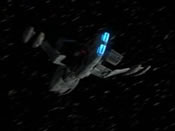 |
Built in the early 2130's to offset the production of the largest of Vulcan warships. Handily dispensed with the largest Vulcan craft in the late 22nd Century. |
Andorian Capital
Ship |
|
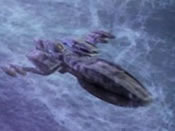 |
This was the standard cruiser used by the Andorian National Fleet. The last of the strictly Andorian manufactured craft. Upon entering into the United Federation of Planets, their designs specifications were considered unsafe and ineffectual for mass production. They turned to UFP designed craft in the late 22nd/early 23rd century. |
Andorian Light Cruiser |
|
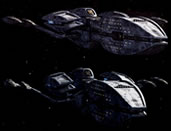 |
This was the standard destroyer used by the Andorian National Fleet which began production in the late 21st century. Stood at 500 meters from bow to stern. Were used extensively during the Romulan War for their greater speed gains. Most were lost. |
Andorian Destroyer |
|
Andorian religion is simple, practical and utterly without theological speculation. Andorian "gods" are always deified spirits of heroic ancestors or personifications of natural and psychological forces - or combinations of the two. They have straightforward and practical functions (guiding their descendants, bringing rain, promoting fertility, protecting the herds, etc.), and are seen as having attributes and limitations much like those of their worshippers. For example, the war-god Fierce Larashkail is usually depicted as armed, embattled, enraged, and pregnant - the epitome of a fierce male Andorian warrior. The limitations of the gods are accepted in the standard nodes of worship.
At the peak of the stormy season, they have a period of fasting, prayer, and sacrifice to the Water Guardian, begging for deliverance, signalling the beginning of the Spring Water Festival (in November of the Terran calendar). The symbol on each family's door was to remind the Water Guardian that true believers lived within and to pass them over. In the old days, it would have been painted in the blood of the eldest shen in the house.
Guardians:
Water Guardian - iconograph is four interlocking squares that form a quasi-star.
Star Guardian
Earth Guardian
Fire Guardian
Tale of the Breaking:
Thirishar rose up with sword in hand and challenged the gatekeeper of Uzaveh, saying, “I have done as your Master commanded. The tasks are completed. Now let me pass or face the same fate as those who were sent forth to stop my quest.”But Uzaveh the Infinite, watching from the Throne of Life, was amused that this creature, made of little more than the dust of the universe, dared demand entry at the gates. To spare the gatekeeper from the warrior’s death-blade, Uzaveh bid Thirishar enter.
Thirishar walked proudly down the Path of Light, believing that as the first to complete the tasks of Uzaveh, the Empty Throne beside the Infinite, the Throne of Secrets, now belonged to the Greatest Among Mortals. Had Thirishar not earned the right?
But wise Uzaveh, omnipotent and omniscient, Eternal and Infinite, knew that the warrior possessed the power and knowledge to conquer all challenges, save one.
Uzaveh held up a hand, and Thirishar halted.
“Are you Whole?” whispered Uzaveh in a voice that shook the universe.
But the warrior did not understand the question. “I am Thirishar. I claim the Empty Throne.”
“No,” answered Uzaveh. “You are unworthy, for you are not yet Whole.”
Thirishar trembled and knelt before the Uzaveh, for the first time understanding the arrogance and the vanity that had misled the mortal to this moment.
Still, Uzaveh had mercy.
Death was not to be Thirishar’s fate.
“Instead,” decreed Uzaveh, “from one, there shall be four.
“To one shall be given wisdom to be a protector—the cunning warrior who shall fight for the future.
“To another shall be given strength, providing a foundation upon which the others can build.
“One shall be given blood, the river of life that shall flow among the others, providing nurture and sustenance when the flesh longs to yield.
“And to the last shall be given passion, for the flame of desire will bring change to the others and warm them when the chill is bitterest.”
So Thirishar became four: Charaleas became wisdom; Zheusal became strength; Shanchen became blood; Thirizaz became passion. Together, the four are the First Kin.
Uzaveh banished the four to the farthest reaches of the kingdom and upon seeing them there, so far from the Thrones and utterly alone, appointed for each a guardian.
For Thirizaz, the Fire Daemon fed the soul-consuming passion. Loving Shanchen became a vessel for the Water Spirit, forever bound to the Eternal love flowing from Uzaveh’s Throne. For strong Zheusal, Earth became protector. For wise Charaleas, the Stars became guides, their light defying darkest night.
“When you are Whole, as I am Whole,” Uzaveh said, “then shall you return to my presence and assume your place at my side.”
—From The Liturgy of the Temple of Uzaveh;
Third-Century Codex
by Heather Jarman, "Worlds of Deep Space 9: Andor"
 |
The Andorian
representation of the Phoenician alphabet |
The Andorii Language (or the locally used term, Fesoan) reflects much
of the highly stratified class system, so firmly entrenched in the culture
of Andor, Piin'tel, Aad'hozh, Em'phur, and their colonies. The Andorian
psyche is prevalent in many of the aspects of the language, as is to be
expected in the linguistic study of any language system.
Physically, they are blue-skinned humanoid bipeds with white hair and knobby antenna on the crown of their heads. They lack visible ears. Andorians are the only species known to the Federation that display characteristic of both mammels and insectoid species. Like standard mammalian humanoids, the Andorians are warm-blooded, bear their young live, have an internal skeleton to which the body's muscalature is anchored. However, they also feature a limited exoskeleton which lends added strength and protection of the limbs end torso.
A sub-species of Andorians known as the Aenar had white skin; unlike the blue Andorians, the Aenar were blind and telepathic. Andorians and Aenar are genetically compatible and can produce offspring.
Andorians have four sexes: zhen, shen, chan, and thaan. The reproductive functions and appearances of zhens and shens are roughly equivalent to those performed by females in two-sexed species, while chans and thaans are roughly equivalent to males in their biological function and appearance, though shens and chans are often perceived as being somewhat androgenous-looking to two-sexed species. The four-sexed paradigm, is depicted as being responsible for the Andorian species having great difficulty maintaining replacement level population growth and facing extinction.
Often, once the quad has created offspring, they separate to pursue their own interests.
The Andorian retina is composed entirely of intensity sensitive rods and is incapable of discerning colour. Colour is, however, added to Andorian vision by the dual antennae, which in addition housing auditory receptors, feature a complex matrix of light-sensitive cones. These cones cover the spectrum of colour visible to Terran eyes, as well as limited infrared wavelengths. 8ecause of the correlation of four independent light receptive organs, Andorian vision can be correctly described as "quadronsonic" resulting in superior depth perception.
Their auditory capacities are also highly developed, allowing Andorians to hear a wider range of frequencies than is possible for most humanoid species. Because of their monodirectional antennae, the Andorian-people usually listen with the heed down end slightly tilted. The antenna face forward and cannot rotate, causing Andorians to hear better from the front and sides than the rear. Each of the two antennae stalks are susceptible to damage and injury. Any hit will cause intense pain to an Andorian. If one stalk is destroyed, the Andorian can still "see" but at a loss of what was before. If both stalks are destroyed, the Andorian becomes deaf and color blind. Andorian are all ambidextrous.
Andorians are a comparatively tall species, averaging between 1.7 and 2.1 meters in height. Although obesity is not unknown, it is culturally condemned and most Andorians are quite slender for their height. This often gives them a misleading appearance of fragility, which is belied by their remarkable physical strength. Due to the extreme density of bone and muscle tissue, the average Andorian is quite capable of lifting an object of twice his or her weight.
They have a higher metabolism than humans and are very susceptible to high temperatures. An Andorian could lose 10% of its body weight in as little as two days in climates approaching the boiling point of water.
Neither diurnal nor nocturnal, but completely adapted to living and working day and night, they only need to sleep one-eighth of their thirty-two-hour day.
Shen are the female gender that can be impregnated. They carry the child to birth and then it's placed in the Zhen's kheth - the temporary pouch that grows over and around the lower abdomen of a zhavey (Zhen mother) for the final phase of Andorian gestation.
Ther is an optimal 5-year period where bondmates have the highest probability of procreating. After this has passed, the ability to reproduce is greatly reduced.
Like mammals, they are warm-blooded, bear their young live, and have an internal skeletal structure to which their muscles attach. Like insects, they have a limited exoskeleton which gives them extra damage resistance from attacks.
While the eyes of an Andorian are actually color blind, their antenna have very good color receptors in them, and also hold their hearing apparatus. Their mechanisms for color vision and hearing are so good, they give Andorians the advantages of infravision and ultrasonic hearing. Antenna movement apparently expressed feelings as well. An Andorian would sometimes point their antennae at a potential mate to signify attraction.
The antenna face forward and cannot rotate, causing Andorians to hear better from the front and sides than the rear.
Each of the two antennae stalks are susceptible to damage and injury. Any hit will cause intense pain to an Andorian. The Andorian was partially disabled and unable to fight immediately following the loss of an antenna, but was able to compensate this within a day or so. The antenna itself could take up to nine months to regrow on its own, although the regeneration could be completed in around half that time with electrical stimulation and cranial massage therapy. The loss of an antenna was a humiliating experience for an Andorian to come to terms with.
If one stalk is destroyed, the Andorian can still "see" but at a loss of what was before. If both stalks are destroyed, the Andorian becomes deaf and color blind.
Because of the importance of the antennae, much of Andorian psychology revolves around these organs. Fear of damage to the antennae is deeper and more widespread than castration anxiety in humans. Loss of antennae to an Andorian is the equivalent of deafness, muteness, castration and mutilation of the face to a human, and no Andorian will voluntarily survive such an injury. Subsequently, the uninvited touching of the antennae is considered an unpardonable rudeness, and the threat of injury to antennae is legitimate grounds for assault and murder - as occasional, unfortunate incidents have shown.
Because of the telepathic organs and their relation to the reproductive process, the antennae are also considered proper sites for valuable jewelry, particularly gifts from friends, lovers and mates. The Andorian version of the wedding ring is worn on the left antenna rather than on a finger. To give an Andorian antenna rings or antenna bells is to make a gesture of great friendship, if not of courtship.
The Andorians regard themselves as a passionate, aggressive,
even violent species, however, their character is much more complex. At
first glance, the intelligent, apparently intellectual humanoids give
the impression of being deadpan and emotionless, very calm, rational and
logical like the Vulcans, but different from them, their indeed existing
emotions can emerge with intense psychological and physical reactions.
Andorian culture is predicated on the Clan. A Clan these days is a group of 60 to 100 families who have banded together to pool their resources and abilities to provide for the whole of their number. Clans tend to grow around single lines of endeavor or related centers.
They are a militaristic warrior race. This was underscored by the fact their weapons had no stun setting. Service in the Andorian Imperial Guard is considered honorable and military ranks have a great influence on social reputations. However, Andorians never fought without reason, and deplored dishonesty, though they were capable of duplicity. Andorians considered their race to be deeply emotional and passionate, and although they were not known for their charity and have few sympathies they placed a high value on family.
Andorian culture is divided into the "Coastal'' and the "Inland'' races. Those who live in coastal cities constitute about 60% of the total population, and have been the centers of technological development. The inland plains are home to semi-nomadic inland Clans, who even today remain devoted to their ancient heritage. These cultural groups have minimal contact at this point, with increasing disdain on both sides.
There are 4 traditional rituals among the Andorians: the birth, the Time of Knowing, the “turning age”, and the wedding.
Nutak - When a new Andorian is born, there are 4 days with a “welcome” ceremony. They celebrate freedom from the egg, and arriving to this world. In the last day, it receives a bless from the priest. Moments after birth, the child's genetic structure is captured to be mapped and matched against the most compatible bondmates.
Time of Knowing - When bondmates become aware of each other for the first time during their mid-teens. They each contribute a strand of hair to each other to be interwined into a pendant or locket called a Shapla. A series of truths taught while young pronounces the importance of the bond.
The First Truth:
“One alone cannot be Whole—nor two, nor three. What one chooses, is chosen for all, what befalls one, befalls all. Their lives are yours... My life is theirs."
Remali'y - The Andorian “turning age” ritual is a ceremony to celebrate the arriving of the adult age. It takes 3 days, first day the “turning age” is alone with a mentor (preparation), second day is alone with themselves (meditation), and finally, in the third day they are accepted, in a formal ceremony, among the adults (consumption).
Fomel - The Andorian wedding more remarkable characteristic to non-Andorians races is that it requires 4 mates (spouses). Andorian wedding is very ceremonial, takes ten days, and involves the families, friends and more distant relatives. During this period, the mates are in constant contact with all the people and unable to consummate the union. In the first three days, the mates don’t see each other, and they participate to “preparatory rituals”. In the fourth day, a priest marries them all, the fifth and the sixth are used to meditation, and then they have 3 celebration days.
Whole Vessel Law
Legally allows bondmates to separate before reproducing through the shelthreth. Usually must be declared by the separatee's zhavey.
Andorians see the death as natural, but they believe in a life after death. They don’t mourn so much, as they believe that the spirit is finally free. They have special places to bury their dead, too, but no special ceremony.
The Sending
A ritual performed in the same sense as a funeral. All the pieces of the deceased's life are re-assembled through family and friends before sending them on. Involves several days of rememberance, eating, and dancing.
Rite of Memory
Those closest to the one who has died record a memory of the deceased onto a crystal called the Rite of Memory.Shapla
A pendant or locket, usually containing a strand of hair from each bondmate, signifying a term of engagement given at the Time of Knowing. The remainder of the quad each return theirs to the deceased to make them Whole.Mask of Grief
Each individual attending the deceased's Sending creates a mask of grief representative of their feelings.The funeral bier arrives on the shoulders of six bearers, accompanied by the First Kin - those remaining in the bond clad in traditional garb - plus a priestess of the Guardian representing the deceased, and the zhavey of the one who has died, carrying the Cipher of the Rite of Memory.
The coffin is placed upon an altar while the priestess sings the Tale of the Breaking, and the mourners surround the First Kin, wearing shrouds of white with the Masks of Grief upon their faces.
“Who comes, seeking safe passage for <deceased>?”
Together, the First Kin say: “We, her Whole, do.”
The priestess then opens her arms to the sky. “As we return <deceased> to you, the great Guardians of the Night, we plead for his/her safe passage to his/her next life. From you, Mother Stars, came the substance of his/her life, which you poured into the vessel of her parents to give his/her form. To you, Mother Stars, we return him/her. Who will send <deceased> home?”
After declaring that she will send the deceased, the zhavey places the Cipher into a notch just under the head of the coffin, and gives it two hard turns to ignite the funeral pyre.
Andorians thinks highly of knowledge, culture, work and nature. Different from other cultures, they do not valorize recreation and sports, with exception of martial arts. The educational level in Andoria is very high, all villages have schools, and we can find universities in almost all cities. The high level of Andorians universities is known in all of the Federation. From age three to twelve, it’s obligatory to the Andorians to attend primary school. There is a secondary school, that goes from thirteen to eighteen, and opun graduation, university. Although just the primary school is obligatory, 1.5% of the Andorians don’t finish their university studies. Art is another important factor in Andorian life. They cultivate their art, and valorize their artists, too.
Thaan's and chan's represent Andor's warriors, with chan's wearing chain mail during Spring Water Festival to differentiate the two. Zhen's and shen's represent the reproductive side of society. Zhen's wear traditional garb, where shen's wear the same but for an open back to denote a sign of fertility.
What follows is a short list of those words and a few others established in Deep Space Nine fiction set after the TV series.
Because the economy is the chief activity of the clan, religion, art and education are shaped by their relevance to clan economics. Education, particularly on technological subjects, takes precedence over art - which in turn takes precedence over religion. Wandering neuters tend to transmit information on these subjects in the same order of importance, with the result that technological change spreads quickly, artistic innovation more slowly - and religious development progresses hardly at all. Thus, Andorian culture presents the spectacle of a space-age technology, a mediaeval level of artistic development and a religious mode usually associated with the Late Stone Age.
Andorian science began, understandably, with advances in animal husbandry, ecology, veterinary medicine, defensive architecture, military engineering, and weapons technology. Such advances gave their discoverers advantages over their neighbours and thus spread rapidly, by conquest or transmission by wandering neuters, throughout the society. This insured evolutionary direction toward greater intelligence, higher creativity and further technological progress. Any clan that could produce a creative genius was practically guaranteed a fine and well-fed future.
Unfortunately, the cultural pressure toward purely practical rather than theoretical science has tended to constrain the direction of progress in a few areas. One example of this is the surprising absence of an Andorian-developed faster-than-light space drive. Lacking the necessary backing of purely theoretical mathematics and physics, the Andorians never discovered the principles of FTL drive - which is why they didn't colonise the galaxy long ago, although they have had space travel longer than any other species in the Federation.
The Andorians managed to colonise all twelve planets in their home system, but found the time factor of sub-lightspeed journeys an insurmountable barrier to interstellar colonisation. They did attempt interstellar journeys with sleeper ships and generation ships, but found that sleeper ships fell easy prey to random accidents and that generation ships had a lamentable tendency to break up in civil wars.
The Andorian word for art derives from the ancient words for family amusement and ancestor glorification and it is not surprising that Andorian arts are somewhat limited in scope. The plastic arts are primarily decorative (including tapestried blankets and hangings, colourful pottery, intricate jewellery and embellished weapons and utensils), or functional (such as religious idols and icons, commemorative statues, family portraits and educational illustrations of clan histories).
The Andorian Academy was considered by many to be the best art school in the Federation.
Literature is limited to historical drama (popular mainly in urban areas), literary poetry (written and read primarily by wandering neuters) and song (usually folk ballads meant for the edification and amusement of clan gatherings). Andorian drama bears a strong resemblance to early Elizabethan theatre of Earth in its length, complexity, structure, subject matter, language, and luridness; reviewers often complain that by the fifth act, the players are having difficulty moving about because of the numbers of bodies littering the stage. Literary poetry, although comparatively free and innovative in form, tends to confine its subject matter to mood pieces, usually love songs. Sung poetry is primarily of the sing along ballad variety.
A crucial part of Andorian tradition was the so called ushaan, a code of honor demanding a duel to the death in which the combatants fight against each other with a ice miner's tool, the ushaan-tor. An enormous body of rules and regulations existed around this code of honor, summing up to 12,000 amendments. The Ushaan could be demanded by someone as a means of personal vengeance, e.g. to avenge a personal loss. However, there existed a right of substitution, allowing each combatant to put up a replacement for themselves. Furthermore, each married combatant could postpone a duel indefinitely, if there were no children to continue his claim. Additionally, the fight might be called off, if one combatant disabled the other in way so he could not continue the duel.
If a member of the Andorian Imperial Guard died far from home, his or her companions carried a part of the body back to the ice of Andoria.
Andorian Terms:
ceara: traditional clothing among zhen
challorn: a sweet-smelling flower
eketha: a hardwood tree
elta: a floral tree
grelth: an arachnid
hari: a flatbread
katheka: a stimulant analogous to coffee
kheth: the temporary pouch that grows over and around the lower abdomen of a zhavey for the final phase of Andorian gestation
klazh: an animal known for its careless way of moving
saf: a psychoactive chemical refined from an Andorian plant, used in the shelthreth and generally available only by medical prescription on Andor. Possession of saf is illegal off Andor
shapla: a betrothal symbol; woven locks of hair from bondmates
shax: a poisonous Parasitic insect that nests under the skin of its host. Shanchen’s mantle is a salve that provides temporary relief.
shaysha: an edible beetlelike insect
shelthreth: ritual consummation of marriage for the purpose of conception.
taras: a kind of tree
tezha: sexual union outside the shelthreth
vithi: an edible flower
xixu: a marine plant whose fronds may be mashed and used in baby food
zhiassa: a zhavey’s milk
zletha: a flower
The Deepening: The beginning of the Andorian day. Terran version would be midnight.
Andorian history is one of conflict and war. The Andorians evolved from warring factions into a paranoid space faring race. Once in space the Andorians quickly found new races to war with. Nearly the ushering in of a new age of seclusion and paranoia ended a 100 years of space warfare. Eventually the Andorians were able to over come their fears and branch back out into space. But this time, they are doing so in a manor that best reflects a society that prefers to know thy enemy and to that end they are now know as one of the best races for intelligence and covert actions.
The Andorians did have advancing physics and were developing their own warp drive capability when contact was made. They refused the offer from the first contact teams to share warp drive technology. Although humans and Andorians had limited contact after their initial meeting, with some trade and cultural exchanges, each group found the other too "alien" to easily get along with. The idea of insects, over hundreds of millions of years, evolving into larger, sentient, humanoid-like creatures, was almost too much for the human psyche to take. However, stronger relations did come during the Romulan Wars of the middle twenty-second century, when the Andorians allied with Earth and proved themselves to be worthy interstellar warriors. As a result of improving relations, Andor was invited to be a charter member of the Federation, which was formed after the Romulan Wars ended. Although a part of the Federation, Andor continues to design and build its own ships. Andor also maintains the Andorian Starflight Training Institute for training the crews on its own ships. Outside of the Andor system and its colonies, the Andorian ships work under the control of Starfleet Command.
Reiji:
An old clan who long
ago gave up their land and titles to become nomadic. They welcome visitors and negotiate goods fairly.
It’s believed that the Andorian race has its origins in the southern continent, Mangea, during the Glacial Period. In that time, glaciers and ice fields covered a large portion of Mangea. It’s very probable that this is the main cause that Andorians are to a degree endothermic, in having troubles maintaining their body temperatures when external temperatures are over 30º C. When exposed to such circumstances, they abandon their logical processes, and become easily irritable, with more prominent violent characteristics. The average Andorian body temperature is about 29º C. Andorians used to build their dwellings in the underground, probably instinctual to live in colder circumstances. Very few facilities and other structures were built on the surface.
During the Pre-Historic Period, when the Andorian tribes were nomadic, there was the First Migration. Some tribes migrated northwards, finding land and food. But as they reached the planet’s Equator, the higher temperatures increased their violent tendencies. In the middle of this period, Andorians developed agriculture, which in turn made it possible to begin establishing settlements. In the South, the first cities began to form, while in the central regions, the tribes were semi-nomadic. The tribes in the central regions had a slower technological development, most likely because of the temperature, and they were more aggressive than average, fighting for land and food even if they had enough of both. During this period, some tribes continued their migration northwards, and reached the Northern part of the planet where temperatures were lower, akin to the South. Those tribes who already arrived with some agricultural concepts, settled like the southern tribes.
It was during this period that Andorians learned the rudiments of agriculture, animal domestication, bronze working, religion, masonry and the basics of commerce. The development in the southern and northern tribes were faster and more consistent than the central tribes, yet not overly. Even more aggressive, Andorians continued to be efficient. Fights were a constant occurrence in the North and South. Commerce among tribes slowly intensified.
During this period, the settlements were based in regions with natural water. Once Andoria had no oceans, like Earth or Tellar. Settlements were located along the river’s coast and oases, both of which were found in abundance all over the pioneered regiosns of the planet. The climate and food in the North and South were more difficult to deal with than in the Equatorial regions, but they developed quite effective agricultural techniques and hunting to offset this issue. It is not a much documented period, of course, but there are quite a lot of tracks found in historic research.
At the very beginnings of the Andorian Cooperative lifestyle was the Bond of the Words Unspoken, or the Khun-Haga, in which an individual pledged trust and service to the Tyk, in return for which the Tyk pledged the same to the individual. The Andorians understood that making this covenant a deep and binding extension of their thoughts and lives was the only thing that kept their fragile tribes safe and together, and being a stoic people, made it a point of honor to never speak to one another about the bond. No thanks were ever given for supporting the Tyk, and no explanations were ever offered to outsiders about the specific nature of the Tyk's unspoken bond. The only thing that was recognized by all was that the Khun-Haga was a force in Andorian life more powerful than the spectacular desert lightning, and herder to break than the rare and powerful bellium weapons forged by the first Delvers.
The names of Andorians often consist of two names in the Andorian language, Andorii -- a personal name that is often quite long and shortened to something more akin to canonically-established Andorian names, and a clan name that is preceded by a prefix indicating sex. "Thirishar ch'Thane," thus, is a chan from the Thane clan who is commonly known as "Shar," for instance.
Andorian names are harsh sounding, often very long affairs difficult for foreigners to master. In their full forms, however, they are poetic descriptions of a single scene or moment that was of great significance to the naming parent. In this way Andorian names are similar to Japanese Haiku. For instance, the full Andorian name Krymerik Guon Kaniaky she Zhukarak du Yutmakiat Shulkee na ah Huit might literally translate to "l sat by the oldest stones on the high south bluff while far desert lightning fell to set the red sands singing". The poetic conventions for such naming compositions are far too complex to adequately deal with here, but suffice it to say that most Andorians names are heavily weighted down with Ys, Ks, Gs, Ts, Ds and Us, and that outside their immediate cooperatives, most Andorians simply go by the first word in their Namesong. The Andorian whose name is given above would simply be referred to as Krymerik, for instance.
They add gender pronouns upon their general-use last names, such as zh'Loran, sh'Loran, th'Loran, or ch'Loran, to give the two-gender common species a method of ascertaining a proper form of address. This is to alleviate the Andorian species from having to explain their biology, which they consider extremely private and embarassing to speak about outside of their species.
Last names are inherited from the zhen.
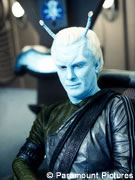 Shran |
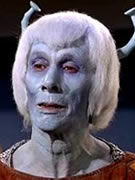 Shras |
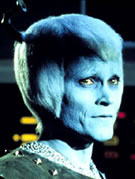 Thelev |
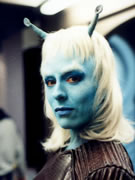 Talas |
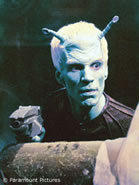 Keval |
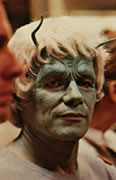 Unknown |
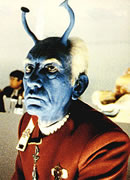 Igrilan Kor |
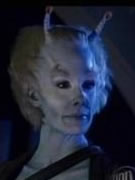 Lt. Tarah |
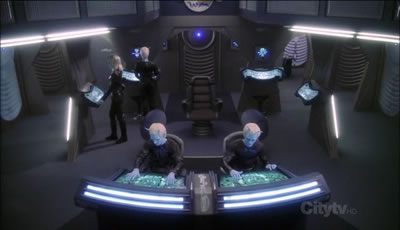 |
|||
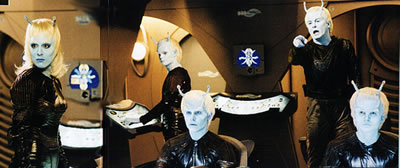 |
|||
1.
USS Galaxy Play by Email Writers RPG
2.
A Summary of the Physiological Roots of Andorian Culture
3.
Andor Confederation
4. Andorian entry in Star Trek Wikipedia
5. Worlds of Deep Space Nine 1: "Cardassia and Andor" - Part 2, by Heather Jarman